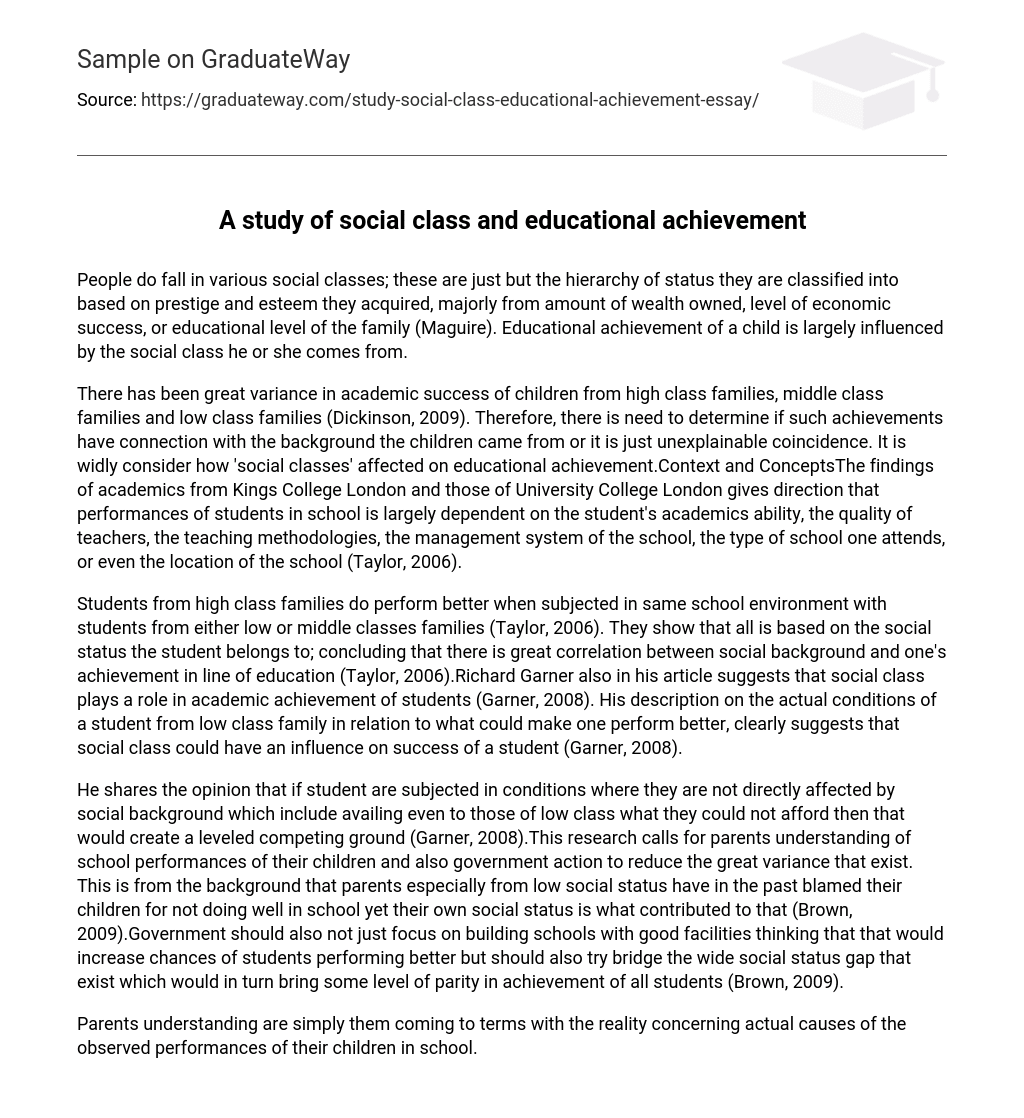Maguire states that individuals are categorized into various social classes according to the prestige and esteem they have attained, which is primarily determined by their wealth, economic success, or family’s educational level. Moreover, one’s social class significantly impacts their educational achievement.
Extensive research (Dickinson, 2009) has focused on the influence of social classes on academic success. Hence, it is vital to assess whether these accomplishments are influenced by backgrounds or simply random chance. A study carried out by scholars from Kings College London and University College London emphasizes the significant effects of multiple factors like a student’s academic capability, teacher quality, teaching approaches, school management systems, as well as the type and location of their school on their academic performance (Taylor, 2006).
Taylor (2006) states that students who come from high-class families perform better academically when they go to school with students from lower or middle-class families. According to Taylor, a student’s educational performance is strongly connected to their social status. Garner (2008) also agrees with this concept in his article and suggests that students’ academic success is influenced by their social class. Garner examines the challenges experienced by students from lower-class families and proposes that their level of achievement may be affected by their social class.
Garner (2008) posits that providing equal opportunities for all students, regardless of their social background, can level the playing field. This necessitates parents understanding their children’s school performance and the government taking action to reduce existing disparities. The study suggests that parents, particularly those from lower social statuses, often attribute their children’s academic struggles solely to them without acknowledging the significant role played by their own social status (Brown, 2009). Instead of solely concentrating on constructing well-equipped schools as a means to enhance student performance, the government should also address the substantial disparity in social status and strive for equal achievement among all students (Brown, 2009).
Parents’ understanding refers to their acceptance of the truth about the actual causes behind their children’s school performances, while government action entails the measures taken by the government to effectively address the associated challenges.
The main research method and the rationale for selecting this method involve designing a survey questionnaire that encompasses all the essential questions to provide reliable answers to the formulated hypothesis (Statpac). The survey questionnaire serves not only in obtaining quantitative data, which includes statistics and numbers, but also allows for larger sample sizes (Statpac).
To effectively gather opinions, the questionnaire should focus on teachers, students, and parents. It is crucial to substantiate these opinions with evidence by including copies of students’ academic reports. The sample group will consist of 10 parents, 10 teachers, and 10 students from each of 10 different schools. These schools should be situated in areas with diverse social statuses. Printed questionnaires will be provided to the sample group for completion. This sample size will yield reliable data and accurate results while serving as a solid foundation for discussing findings and addressing potential data-related issues. Open-ended questions should be included in the questionnaire to allow participants to provide comprehensive information, ensuring the most conclusive outcomes can be drawn. Additionally, secondary resources such as books, internet sources, and journals will be utilized to review prior research conducted by other scholars to guide the researcher’s own study direction and compare their findings (Engle, 2009).
The researcher will collect the data for this research by visiting schools and meeting with students and teachers. The head teachers of the schools will help identify suitable individuals to complete questionnaires. In addition, questionnaires will be distributed to residents near the target schools. After collecting the data, it will be analyzed by examining each element of the open-ended questionnaire and comparing based on social classes. This analysis will lead to conclusions and provide answers to the hypothesis stated in this proposal.
Potential Problems: The methodology used may be effective and easy to use for obtaining necessary data, but there are challenges associated with it (Pamment, 2011). Questionnaires can make it difficult for the researcher to understand responses. Misinterpreted questions can lead to valueless answers (Tampere University of Technology). Some individuals may fabricate information or feel embarrassed, leading to misleading data. Collecting and analyzing questionnaire data from the sample population would be time-consuming due to the open-ended nature of the questions.
Conducting research can be a difficult task that requires reaching a diverse sample, ensuring they fill out questionnaires, and analyzing the collected data (Presser, 2004). Moreover, sufficient funds are needed to cover the costs of designing and printing questionnaires as well as the expenses of traveling to various locations. In addition, conducting successful research requires dedicating time and energy.





